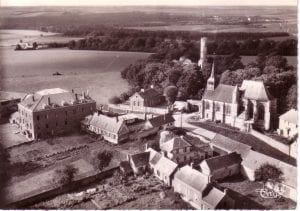 Anyone who has ever visited Folleville has had the exhilarating experience of walking back in time. This tiny country church belonging to the Gondi’s was the site of the first sermon of the mission preached by Vincent de Paul on the Feast of the Conversion of St. Paul. It is one of those heritage places in France where one can still feel the palpable presence of Vincent.
Anyone who has ever visited Folleville has had the exhilarating experience of walking back in time. This tiny country church belonging to the Gondi’s was the site of the first sermon of the mission preached by Vincent de Paul on the Feast of the Conversion of St. Paul. It is one of those heritage places in France where one can still feel the palpable presence of Vincent.
The church itself is divided into two parts. The front and older part is a simple barrel vaulted country church dedicated to St. Jacques (the chapel operated as pilgrim’s way-stop on the famous northern pilgrimage route to Compostella). The rear portion of the church added at the beginning of the 16th century is a magnificent, flamboyant gothic structure built as a funerary chapel for the De Lannoy family (Madame de Gondi’s family). It contains the fabulous mausoleum of Raoul de Lannoy and his wife Jeanne de Poix, and once also contained the famous sepulture of Christ sculpture grouping now located at the church of St. Jean in Joigny. (The DeGondi’s moved the sculpture there when they sold their lands in Folleville.)
 Over and above the chapel’s Vincentian Heritage, its importance in the history of French ecclesiastical sculpture and architecture is well known. The church as it now stands has suffered from ill-considered additions, subtractions, thefts, and all the ravages that history can throw at a building. For example, in the nineteenth century the rood screen which had separated the two parts of the church was dismantled. Yet, the remaining original fabric is still much greater than the losses it has suffered.
Over and above the chapel’s Vincentian Heritage, its importance in the history of French ecclesiastical sculpture and architecture is well known. The church as it now stands has suffered from ill-considered additions, subtractions, thefts, and all the ravages that history can throw at a building. For example, in the nineteenth century the rood screen which had separated the two parts of the church was dismantled. Yet, the remaining original fabric is still much greater than the losses it has suffered.

The Vincentian Studies Institute at DePaul University has commissioned the distinguished diorama artist Jeff Wrona to construct a large scale model of the church at Folleville. The model will recreate what the church would have looked like on January 25, 1617 as Vincent stepped forward to preach. In 1992, Jeff created the diorama of old Saint-Lazare in Paris as it would have appeared before the French Revolution. That model continues to be on public display at DePaul’s Richardson Library. Jeff has done two extensive site visits to Folleville, and has been working on preliminary drawings, material tests, and other projections. He will soon begin work on constructing the model. Serving as consultants to this project are Fr. John Rybolt, C.M., Dr. Simone Zurawski of DePaul, and myself.
When the model is complete, sometime in 2012, it will go on permanent display in the Richardson Library at DePaul. It will also be photographed and digitized so that it can be visited online as part of the Vincentian Virtual Exhibition program of the V.S.I. (More on this program later). Please see the attached images: